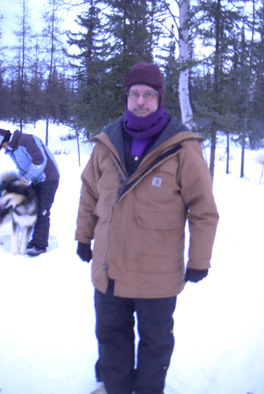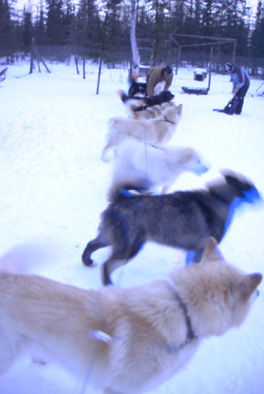FAIRBANKS – They drive on the rivers up here. In winter the frozen rivers are treated as extra streets and even shown that way on maps, until at some point the thaw suddenly sets in, a car or snowmobile falls through, and they close them up for the summer. People also ski pulled by high-speed dogs, sort of like waterskiing on land. It’s called ski-jouring, or something, and is not regarded as evidence of suicidal mental illness. Alaska is not like the lower 48. I’m told it’s homogenized considerably in recent years, but it will never be the same.

I’ll tell you about John Luther Adams’s inspiring new sound installation later – the opening is tonight – but I did get my dog sled ride. Tom and Cathy Dimon of Dimon Freight Dogs, North Pole, AK, run a wonderful business. I thought the clothing I had brought was plenty warm, but as the accompanying illustration shows, Cathy bundled me up in several extra layers, until I felt and looked much like Maggie on The Simpsons in her starfish snow suit. Good thing. The temperature’s been between zero and 20, not the 20 below John had gleefully predicted, but when you’re zipping down the trail at 8 mph pulled by eight eager huskies, you don’t want much more than your eyes exposed to the wind.
What surprised me was the enthusiasm of the dogs. The team selected for my trip were leaping with excitement, the 30 or so left behind visibly and audibly disappointed. Rambunctious but affectionate, they seem human: they understand a wide range of commands, well beyond “gee†and “haw†for right and left and “hold†for stop, and Tom Dimon – standing behind me on the sled – kept up a running conversation with them as though they were old and faithful employees, which they are. I finagled my 23-inch butt into the 20-inch-wide sled, sat on a plastic crate, and pretended to be a sack of provisions bound for Prudhoe Bay, which seemed the appropriate role. Tom released the anchors, and John tried to take a photo of me in the sled, but in their eagerness to stretch their legs the dogs shot off so fast that the photo came out an empty field of snow. The six-mile circular trail traced a rectangle through a flood plain, and so no hills were involved, but there was still a sharp two- or three-foot bump every 30 feet. I feared getting my bones rattled, but the sled was well built to absorb the shocks, and I was never uncomfortable. Jennifer, another employee, rode ahead on a snowmobile to watch out for moose. Moose don’t really distinguish between dogs and wolves, Tom explained, and sometimes a nasty fight ensues.
 This had all been John’s idea and I, no seeker of physical thrills, was dubious until the moment I got in the sled. But from the first rush I was exhilarated. No eight humans could have showed more personal nuance than the dogs; Pepper was thirsty and kept grabbing mouthfuls of snow, Sherman wanted to look back at Tom rather than stay on his side of the line, and kept getting tangled up. The lead dogs were a little young, Tom explained, and though they took charge well, they sometimes paused to argue with commands. Once I slid far enough up an embankment that I expected to be tumbled out into the snow, once the dogs nearly took off without Tom while he was untangling the line, but disasters were avoided, and it was pure effervescence. It became easy to imagine that, years ago, this was the most efficient possible technology for negotiating Alaska’s frozen expanses. People in the back country still do it, for pleasure and for purely practical considerations. So I’m sold: DO NOT go to Alaska, DO NOT, without getting a dog-sled ride.
This had all been John’s idea and I, no seeker of physical thrills, was dubious until the moment I got in the sled. But from the first rush I was exhilarated. No eight humans could have showed more personal nuance than the dogs; Pepper was thirsty and kept grabbing mouthfuls of snow, Sherman wanted to look back at Tom rather than stay on his side of the line, and kept getting tangled up. The lead dogs were a little young, Tom explained, and though they took charge well, they sometimes paused to argue with commands. Once I slid far enough up an embankment that I expected to be tumbled out into the snow, once the dogs nearly took off without Tom while he was untangling the line, but disasters were avoided, and it was pure effervescence. It became easy to imagine that, years ago, this was the most efficient possible technology for negotiating Alaska’s frozen expanses. People in the back country still do it, for pleasure and for purely practical considerations. So I’m sold: DO NOT go to Alaska, DO NOT, without getting a dog-sled ride.
